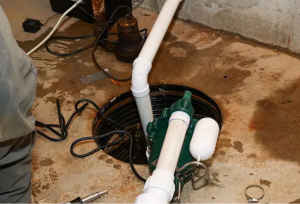 If your sump pump stops working, your basement could flood. That could damage floors, walls, and anything you have stored down there. But before you assume the pump needs to be replaced, there are some easy things you can check yourself.
If your sump pump stops working, your basement could flood. That could damage floors, walls, and anything you have stored down there. But before you assume the pump needs to be replaced, there are some easy things you can check yourself.
Below, this sump pump replacement company in Mettawa, Illinois is going to explain what to look for and what to try if your sump pump stops working.
The first thing you should do is make sure the sump pump has power. Check that it is plugged in and then look at your home’s electrical panel to see if the breaker has tripped. If it has, reset it and try running the pump again.
If the pump still does not start, the problem might be with the outlet or the circuit. At that point, you should contact a professional to inspect it.
It is also best if the sump pump is on a dedicated circuit. And unless your local code says otherwise, don’t plug it into a GFCI outlet because those can trip during storms.
Once you know the pump has power, make sure you look inside the sump pit. Clear out any dirt or gravel, as these can block the pump or jam the float switch.
After heavy rain, check the pit again. If you keep seeing grit or muck in the pit, your drainage system may be drawing in more than just water.
When debris keeps returning even after cleaning, it may be time for a sump pump replacement company in Mettawa, Illinois to take a closer look.
If the pit is clean, try a bucket test. Fill a 5-gallon bucket with water and slowly pour it into the pit. Watch what happens.
The float should rise as the water fills up. Once it reaches a certain point, the pump should turn on. It should drain the water and then shut off once the pit is mostly empty again.
If it does not turn on, or turns on too late or too early, there is a problem. The float might be stuck, not lined up properly, or just disconnected. The float is what tells the pump when to turn on, so if it is not moving freely, the pump will not know when to start or stop.
You should also pay attention to what you hear when the pump is running. If it hums, rattles, or sounds louder than usual, it could be due to a faulty motor or a broken part like the impeller.
If you see any of these signs, stop trying to fix the problem yourself and call a sump pump replacement company.
If the pump turns on and off over and over again, even when there is little to no water, it is called short cycling. It could indicate a problem with the float, the pump size, or the wiring. You can try adjusting the float, but if the problem is not resolved, it could be something more serious.
Take a close look at the pump itself. If you see rust, cracks, or corrosion, it is likely a sign of age. Moisture can slowly damage the parts, and if the pump is coated in buildup, it may not last much longer.
Even with good care, most sump pumps last between 7 and 10 years. If yours is older than that and showing problems, you are probably better off replacing it before it fails.
Catching these warning signs early gives you more time to address the issue before the next heavy rain. At that point, a quick repair might not be enough. Your local sump pump replacement company in Mettawa, Illinois can help you decide whether you can keep the pump or need a new one.
If you want to protect your home from water damage, John J. Cahill Plumbing, Heating & Air Conditioning is here to help. As the leading sump pump replacement company in Mettawa, Illinois, we will inspect your current sump pump, explain your options, and install the right pump for your needs. Contact us today at 847-864-5225 to get started.